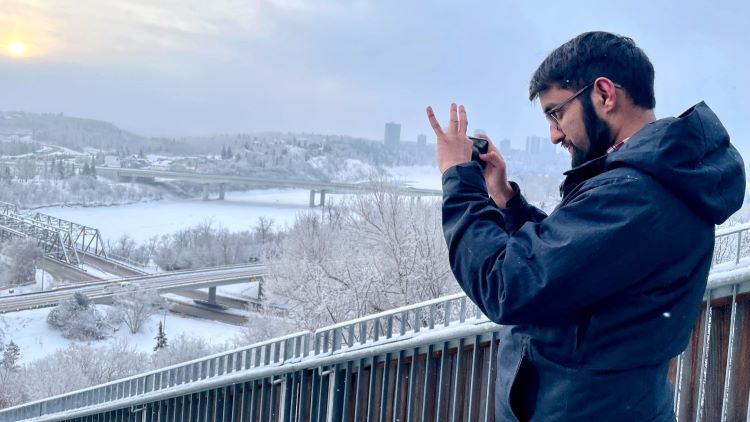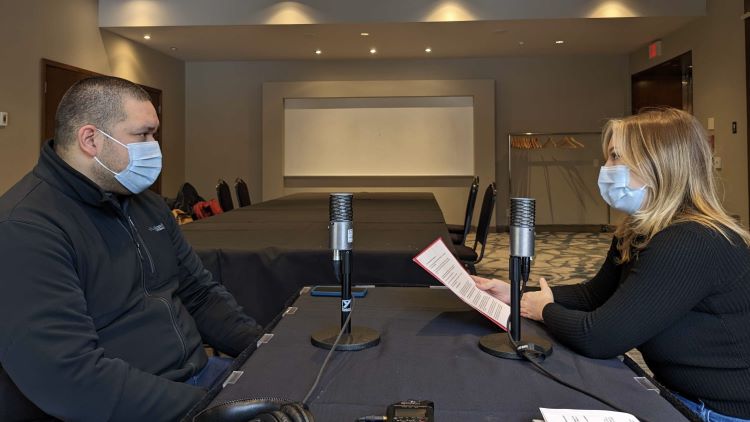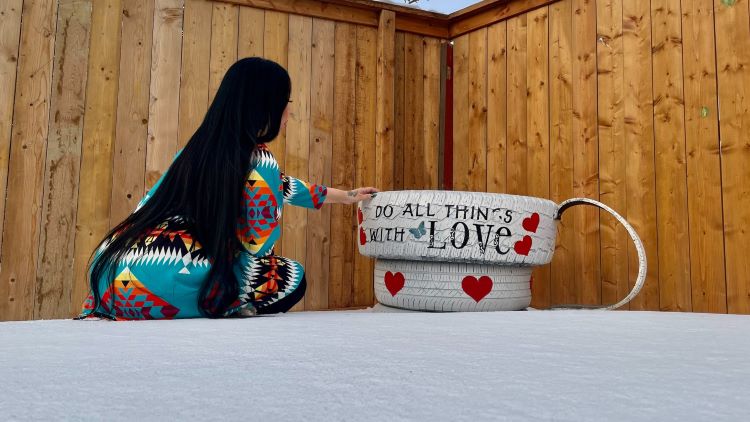Quantifying Anti-Indigenous Hate and Racism with Data Journalism

By Esha Rana
Anti-Indigenous racism and hate are one of the most contentious issues plaguing Canada today. In response, StoryLab, the data-storytelling division of the Office of Research & Innovation, Humber College, decided to conduct a national investigation to better understand the true scale of the hate crimes and incidents. The findings are woven together with a combination of data and stories and published under the fitting title Surviving Hate.
Explaining the origins of this two-year-long project, David Weisz, director of StoryLab, shares: “I was speaking with Martha Troian, a friend of mine, who is an investigative journalist and covers a lot of Indigenous issues in Canada. She wanted to catalogue the incidents of anti-Indigenous racism across the country since there hadn’t been a holistic look at that. I was also interested in the issue.”
Martha is originally from Obishikokaang (Lac Seul First Nation), with ties to Wabauskang First Nation in northern Ontario. She is a seasoned investigative journalist and became the investigative lead for the Surviving Hate project.
“I was seeing a lot was hate and racism in the news at that time,” she shares when asked why she decided to pursue a multi-year investigation into the subject. “So often, especially when it comes to Indigenous people in Canada, we read a variety of hate and racism incidents in the news but they’re one-off stories. It got me thinking about where the data about these hate crimes was and where the investigation was. I didn’t find many reports about anti-Indigenous hate crimes, so I thought this was something we could look into.” She also drew inspiration from ProPublica’s Documenting Hate project, which was an investigation the independent, non-profit newsroom did with a few other news organizations.
“Canada likes to kind of hide in the shadow of the US and say that we’re a lot more multicultural, less racist and more accepting,” David says when asked about the importance of the project. “But we have our own past and continuing present with our treatment of Indigenous people. This project was to help provide a snapshot view and bring this issue to the attention of people.”
Since March, the team has published five stories in the Toronto Star, National Observer and TVO. Five more are upcoming by the end of the year.
Foundational matters
A project of such ambition and import is not possible without an extensive team. Freelance investigative journalists were hired over the course of two years. Additionally, at least eight interns were hired from Humber College while others were hired from the University of Winnipeg and University of King’s College. The project also had two Indigenous reporting fellows through Journalists for Human Rights. Foundational support came from the Faculty of Media & Creative Arts, Office of Research & Innovation, and foundational grants from the Google News initiative and the Inspirit foundation. Consequently, as the leads for the project, David and Martha had their hands full.
“We had several teams at Surviving Hate—an outreach team, a health team and a policing team,” Martha says. “We had weekly meetings for the pitching process to look over the data collected and with our media and funding partners. Overall, as a team, we met to pitch and discuss stories, interviews, access to information requests and story layouts.”
The overall size of the team, though, remained considerably small. Having worked on big investigations previously, David and Martha didn’t want to increase numbers just for the sake of it. “David and I worked to keep the team small. We wanted Surviving Hate to be about mentorship and guiding emerging journalists.”
The team relied primarily on surveys—a feature of crowdsourced journalism—to gather data. The accumulated stories would also form the basis of the more focused and comprehensive investigative reporting about instances of institutional racism towards Indigenous people at the hands of law enforcement, education and healthcare.
Lofty goals and noble intentions, though, aren’t enough to bring projects to life. There were plenty of challenges during the two years of the project, and for David, who was the administrative lead on the project, they were primarily bureaucratic. There were steps to follow, procedures to comply with and boxes to tick. The journalistic tendency to “ask for forgiveness later,” as David put it, would be neither welcome nor understood in a postsecondary institution.
David also worried about how to best work with students—how to ensure that they got something out of the project and that their work could still shine in the shuffle and bustle of more experienced writers. Finding a way to maintain a balance between these critical objectives was another challenge for him.
Amidst all this, however, he is incredibly pleased at having been able to send some of the reporters on location to report. A few went to Halifax, while others flew to Edmonton. “Being able to say that we are doing a truly cross-country investigation and to be able to send journalists that are only a few years or even just a year into their career on assignment to another province is very cool,” David says. It’s also gratifying, he adds, to watch team members grow. Some of them have gone on to work at CTV and others have been hired at Humber College.
A two-year odyssey
“I don’t think I’ve ever had an experience like this,” says Kunal Chaudhary, who is one of the investigative journalists working on the project. “It was a very unique thing. I don’t know how much scope there is for long-form investigations like these. It takes a lot of institutional resources. And while I love that kind of work, and I want to do it again, it is very taxing institutionally and on the reporters.”
Kunal has had former journalism experience with Spacing Magazine, the National Observer, and the West End Phoenix. He heard about Surviving Hate from David McKie who is the project partner at National Observer and incidentally, the person from whom Kunal learned investigative journalism. Led by his interest in hate crime reporting and data collection, Kunal applied to be a part of the project and after an interview that he recalls as being lovely, he was officially a part of the team.
“We kind of did everything,” Kunal shares about the process of gathering and processing material for the stories. “I hopped on multiple stories to help with source finding and the data collection efforts that involved calling dozens and dozens of Indigenous patients who’d experienced neglect and discrimination in hospitals. We had to go through Facebook, social media and word of mouth. There was a lot of drafting, writing and research, and we read dozens of reports about the history of medical colonialism. We were very quiet for a couple of years with the stories coming out at the end, but the entire time, it was an intense period of reporting, compiling information and talking to as many people as we could. I think we talked to more than 100 people for the whole project altogether.”

Behind the scenes, organizing all the information the team had collected was a massive challenge. Kunal notes how a unit put together by the government with millions of dollars in budget and the space to write 80-to-90-page reports, would usually investigate issues like these. Surviving Hate is an academia-backed journalism project which gave them certain freedoms but also other restrictions. A 4,000-word draft, for example, couldn’t be left as it was. It had to be whittled down to 1700-word story. The seemingly endless restructuring and revision was difficult but rewarding, Kunal shares.
His efforts have culminated in three stories. The first one was co-written with Danielle Orr. The second story, “Inside the fight to reform Indigenous health education in Canadian medical and nursing schools,” was a solo endeavour for which he was the lead reporter and recently came out on TVO Today. The follow-up to this is yet to be published and will be Kunal’s final story about the Northern Ontario School of Medicine which, he says, is doing interesting things.
While wading through those bulky drafts, however, Kunal was repeatedly taken aback by the very similar experiences that all Indigenous people seemed to share.
“When you talk to dozens and dozens of people, and they’re all telling you the exact same thing and that they were treated the exact same way, there’s no other way to think about it aside from it being a systemic issue—there’s a level of dehumanization I saw here that really threw me.”
Experiences with trauma reporting
Like Kunal, Danielle Orr too was moved by the accounts that StoryLab heard. Transitioning from private investigation, she drew upon her knowledge and experience reporting on underserved communities at the Investigation Journalism Bureau (IJB).
The first story she headed, “Analysis of anti-Indigenous racism in hospitals reveals pattern of harm, no tracking mechanism,” investigated incidents of racism against Indigenous patients in hospitals. The story was co-written with Kunal and Martha and highlighted that this is a nationwide problem requiring a concerted national effort to address it.
For the second story, “Juliette Tapaquon’s tragic story exposes health-care inequality,” Danielle and the team wanted to focus on the formal complaints process in hospitals and whether it was helpful to Indigenous patients trying to resolve a complaint about racism. They found that it was often a laborious and difficult process for patients, which did not always lead to satisfying outcomes for those looking for justice. Hearing about these stories of systemic neglect, injustice and abuse back-to-back for a year-and-a-half was a heavy experience for the entire team.
“They’re baring their truth and their soul in these interviews, and you have to hold that truth with great care,” Danielle shares about the process. “These are people’s lives; some of them were lost. It’s really traumatizing to not be believed, and at times, through the process of lodging a complaint they weren’t. You have to balance that sensitivity with pulling in multiple sides of the story.”

The common thread in all the accounts she heard was the lack of action. “The response to tragedies is often a lot of, ‘Oh, we’ll make this policy, or we’ll make this standardized process, or we’ll commit to funding this type of thing.’ But at the ground level, it’s not felt enough,” she notes. “The tangible action isn’t always there, and we found that a lot of people are calling for it and even harsher punishments for those who are subjecting these folks to really traumatic racist incidents.”
A big part of the process for the entire team was ensuring that they took care of themselves. Making sure to schedule more joy in her life is how Danielle did it while Kunal found support and levity in leaning on others.
Currently, Danielle is taking a break from investigative reporting and is working as a segment producer at CTV. Going forward in her work, she says she would like to focus more on highlighting Indigenous joy and wellness.
On-location and in-person
A special memory for Danielle was a reporting trip to Edmonton, where she and Kunal went to meet Pearl Gambler, whose story has been highlighted in “Analysis of anti-Indigenous racism in hospitals reveals pattern of harm, no tracking mechanism.”
“You cannot replicate that type of interview. I think it went for three hours, but that’s because we had to take a lot of breaks. We had to give her some space,” Danielle says. “We just sat with her at her home, and I took some photos of her outside. She had a memorial for her daughter. There were some beautiful and tender moments during the time we spent there with her. You just can’t replicate that online.”

For Danielle, being in the field is her bread and butter, and it felt gratifying for her to be in action and making connections with people. “It makes everyone feel a little more human, especially after the last few years we’ve had,” she shares.
Kunal accompanied Danielle on the trip and was as affected by the experience as she was. “It was a hard conversation. Pearl is an incredibly strong person. She just experienced a terrible, terrible thing, but she very bravely spoke about it for a long time. It was very meaningful and underscored the importance of this project and why we’re telling these stories.”
The team seemed to have achieved their purpose when, after two years of intense data collection and writing, the first stories started rolling out. They received many messages from Indigenous folks across the country thanking them for telling these stories.
Working with writers to refine their stories, Martha followed one principle. “I didn’t want to go in the stories with our own agenda or dictating what the story is going to be,” she shares. “‘Let the research lead you.’ Throughout my career, I’ve always followed that guideline. So, we followed the research and practiced due diligence.”
An eye for the future
“There’s real power in being able to put one specific terrible incident in the context that it deserves to be in, which is that these things happen all across the country,” Kunal says about the power of data. “I think that that’s fundamentally what data does — it tells a fuller story. We use data very rudimentarily, but even a basic capacity to communicate the immensity of certain numbers is an incredibly valuable thing when you’re trying to communicate about these issues to the public.”
The power of this data-led language will be crucial for journalists of the future. “We are heading straight for a bunch of crises,” Danielle says. “Journalists have a critical role in not only getting information about crises to people in a timely way so they can make informed decisions and help themselves, but also in bringing about solutions to those crises and ways we can make things better.”
In the midst of doing important work, however, Martha wishes that more newsrooms prioritized mental health and wellness. “It shouldn’t be the norm that mental health is ignored or that a journalist doesn’t feel supported in the newsroom,” she says. “We hear more about mental health now than we did ten years ago, but whether things are being put into practice, we don’t know.”
With Surviving Hate wrapping up soon (though they will keep their main survey open and have not ruled out doing future updates), what’s next for StoryLab?
“I think we’re still trying to figure out exactly where the best fit is within the ecosystem and what we can provide,” David shares. “StoryLab has always had two main goals. The first one is to provide cross-pollination of skills between students and industry so that the industry can take advantage of the upcoming knowledge and cutting-edge things that might not permeate their newsrooms (because younger people are generally the first to get fired whenever there are budget cuts). The second is to take off the load of research and investigation that other newspapers or news organizations might not have the bandwidth for, while providing journalism students solid paid internships.”

